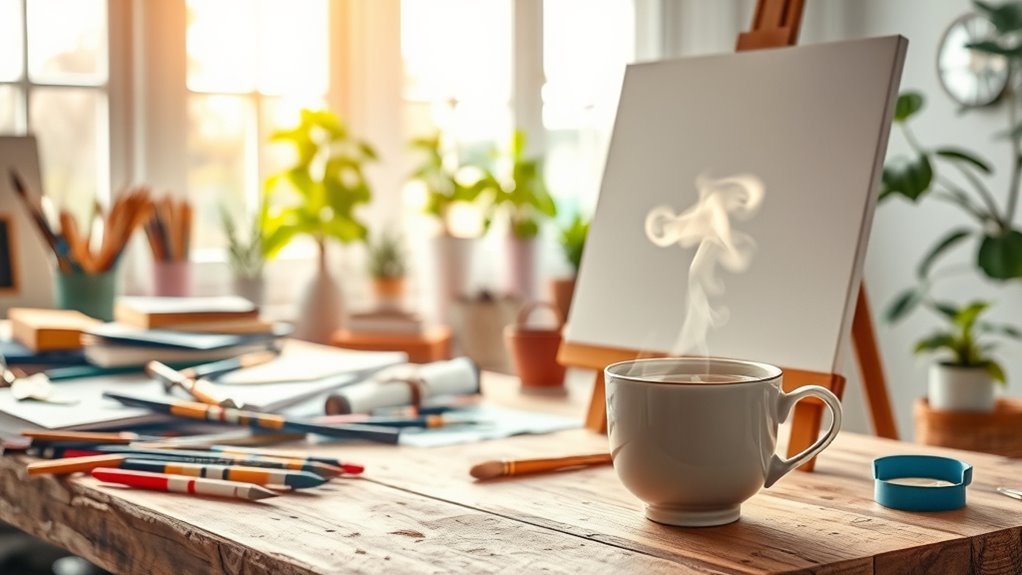Dealing with creative blocks can feel overwhelming, but managing stress is essential for growth. Start by practicing mindfulness and setting realistic goals to reduce anxiety and avoid perfectionism. Taking regular breaks and engaging in movement can recharge your mind and enhance creativity. Plus, cultivating a supportive environment fosters collaboration and fresh perspectives. Embrace imperfections and celebrate small wins to build resilience. You’ll discover even more effective strategies to navigate these challenges ahead.
Key Takeaways
- Practice mindfulness and meditation to reduce anxiety and create a focused mindset for artistic expression.
- Set realistic goals to prevent overwhelm and combat the pressure of perfectionism.
- Take regular breaks and engage in non-creative activities to refresh your perspective and recharge creativity.
- Cultivate a supportive environment through collaboration and positive social media interactions to inspire new ideas.
- Embrace imperfection as a natural part of the creative journey to foster resilience and encourage exploration.
Understanding Creative Blocks and Their Impact
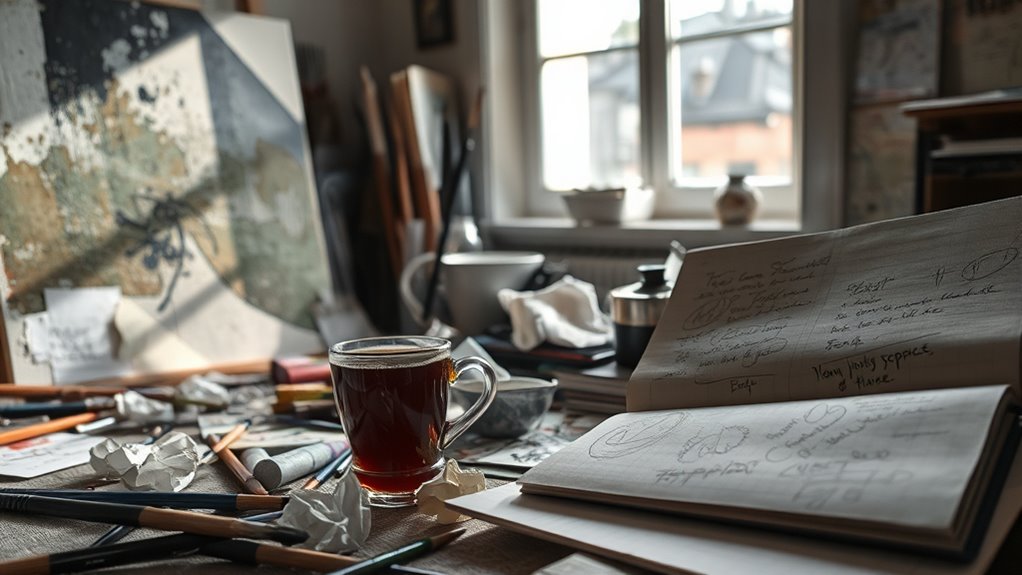
Creative blocks can feel overwhelming, especially when they strike unexpectedly, leaving you grappling with anxiety and self-doubt.
These periods of stagnation often stem from a lack of inspiration triggered by high expectations, perfectionism, or the stress of mundane routines. Emotional healing takes time and patience, and recognizing this can ease the pressure you place on yourself. Acknowledging your need for healthy boundaries can also help you manage the external pressures that contribute to these creative blocks. Additionally, cultivating curiosity can inspire new perspectives and ideas that help break through these barriers.
Creative blocks often arise from the weight of high expectations, perfectionism, and the monotony of daily life.
When you experience a creative block, it’s easy to fall into procrastination and unhealthy comparisons with other artists, amplifying your feelings of inadequacy.
Recognizing that these blocks are common among artists can help you understand their impact on your mental health.
By acknowledging the psychological nature of creative blocks, you can begin to develop effective coping strategies. This awareness is crucial for overcoming creative hurdles and allowing your creativity to flow again, reducing the pressure to constantly produce. Additionally, keeping a design journal can help track your evolving thoughts and inspirations, providing insight into your creative process.
Strategies for Managing Stress and Anxiety

While facing the pressures of artistic creation, it’s essential to employ effective strategies for managing stress and anxiety. Engaging in mindfulness practices like meditation or deep breathing can help you focus on your creative process and reduce anxiety. Additionally, practicing visualization techniques can enhance your artistic mindset and clarity. Incorporating essential oils for stress relief can also provide a calming atmosphere, promoting relaxation and focus.
Regular physical activity, such as yoga or short walks, boosts your mood and cognitive function, lowering stress levels. Glycolic acid can also be beneficial for overall skin health, potentially enhancing your confidence as an artist. Set realistic and achievable goals, like limiting tasks to five daily, to prevent overwhelm and foster a sense of accomplishment.
Establishing a supportive community of fellow artists provides emotional support and encouragement, helping you overcome creative blocks.
Don’t forget to take breaks; stepping away from projects can lead to unexpected insights and renewed inspiration, enhancing your overall creativity. Additionally, incorporating antioxidant-rich foods into your diet can further support mental clarity and reduce stress.
The Importance of Breaks and Movement
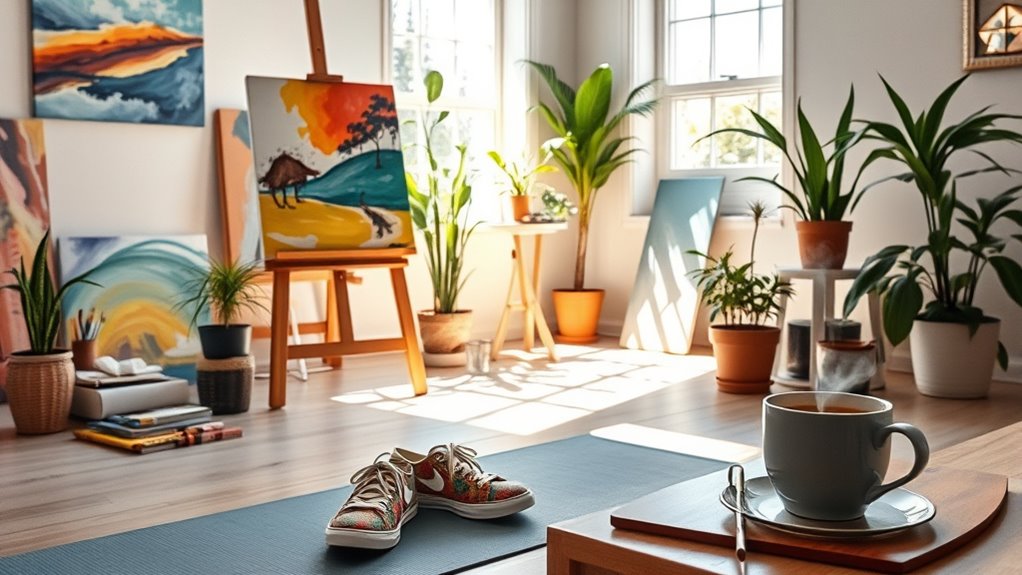
Taking regular breaks and incorporating movement into your routine is vital for maintaining artistic energy. When you step away from your work, you give your mind a chance to recharge, which can greatly boost productivity and spark new ideas. Engaging in activities that promote air quality improvement can also enhance cognitive function during these breaks. Additionally, participating in medication management strategies can help ensure that any cognitive effects from medication do not hinder your creative process.
Regular breaks and movement are crucial for recharging your mind and enhancing creativity. Step away to boost productivity and inspire new ideas.
The incubation stage during breaks allows thoughts to simmer, leading to unexpected creative connections. Engaging in non-creative activities can refresh your perspective and help alleviate feelings of stagnation.
Consider these strategies:
- Schedule short breaks throughout your day.
- Take walks to enhance your creative output.
- Mix in non-creative activities like reading or cooking.
- Establish a movement routine to prevent burnout.
- Use breaks as a time for incubation of ideas and inspiration.
Incorporating movement can also help improve your overall emotional and psychological growth, which is essential for sustaining creativity.
Embrace breaks; they’re essential for overcoming creative blocks!
Cultivating a Supportive Creative Environment
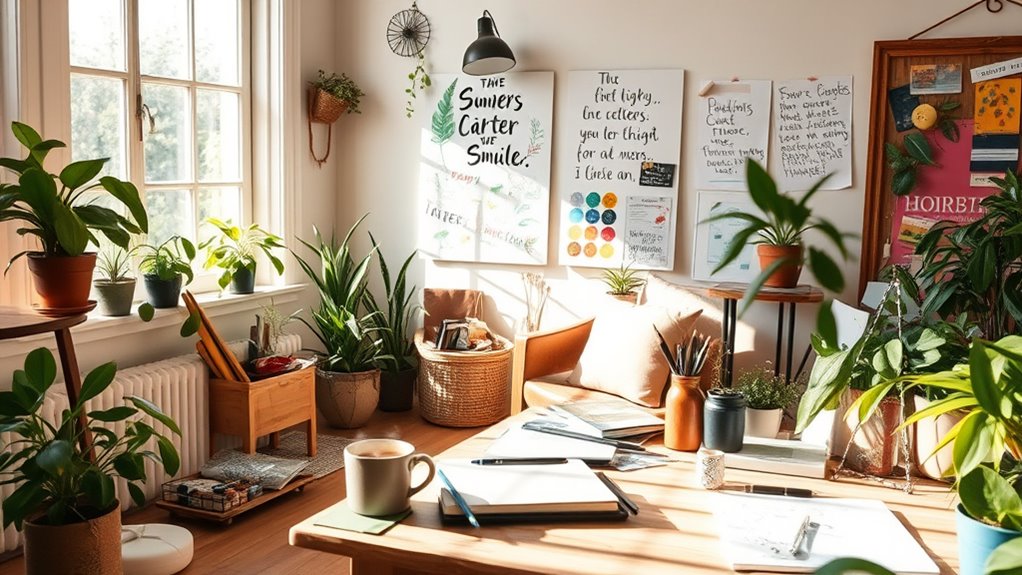
Establishing a supportive creative environment can dramatically enhance your artistic journey, as it nurtures collaboration and connection. When you engage with a community of like-minded individuals, you’ll find motivation and accountability, making it easier to overcome creative blocks. Creating a minimalist environment can further enhance your focus and clarity. Additionally, maintaining a balanced nutrition plan can help fuel your creativity and sustain your energy levels throughout the creative process. A well-organized and accessible living space can also contribute to your overall well-being, allowing you to concentrate on your art without distractions.
Create a designated workspace that’s organized and inspiring; this focused environment can boost your creativity and productivity. Regular participation in group activities or workshops exposes you to fresh perspectives and valuable feedback, stimulating your creative output.
In addition, curating a positive social media feed filled with inspiring creators can serve as a daily source of motivation and support. By surrounding yourself with encouragement and collaboration, you’re better equipped to navigate the challenges of your artistic path. Moreover, embracing silly tantrums during creative sessions can lead to unexpected bursts of inspiration and humor.
Embracing Imperfection and Building Resilience
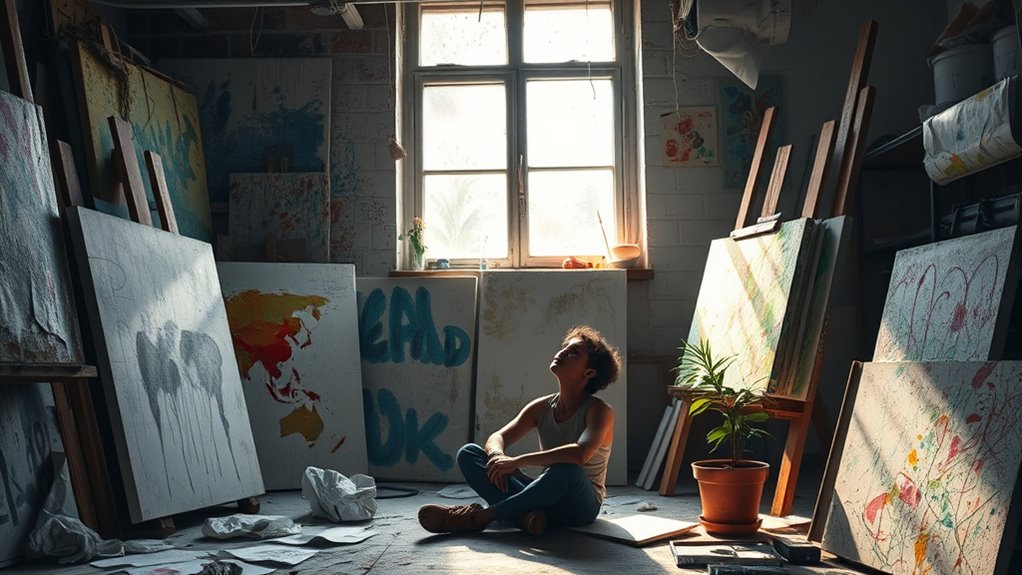
Embracing imperfection can be a game-changer for your artistic practice, as it helps you release the weight of unrealistic expectations. By accepting flaws, you’ll foster a creative environment that encourages exploration and growth. This mindset can greatly lower your anxiety levels while enhancing your artistic expression. Additionally, adopting a proactive mindset can facilitate real change in your creative process. Engaging in active listening to your own thoughts and feelings can further help you navigate through creative blocks and enhance your artistic journey.
Here are some key strategies to build resilience:
- Engage in mindfulness practices to promote presence and spontaneity.
- Recognize that creative blocks are a normal part of your artistic journey.
- Set achievable goals to combat the pressure of expectations.
- Celebrate small accomplishments to boost your confidence.
- Allow yourself to explore different styles and mediums without judgment.
- Incorporate grounding techniques to help manage stress and stay focused.
- Consider incorporating inflation-protected annuities to ensure financial stability, allowing you to focus more on your art without monetary stress.
Frequently Asked Questions
How to Overcome an Artist’s Block?
To overcome an artist’s block, you can start by engaging in daily drawing or writing exercises, like morning pages.
Taking breaks is essential—step away and let your mind wander.
Explore interests outside of art to reignite your passion.
Collaborating with other creatives can offer fresh perspectives, while practicing mindfulness, like yoga or walking, helps clear mental clutter.
How Can You Overcome Creative Blocks?
To overcome creative blocks, you can start by taking regular breaks and engaging in physical activities like yoga or a brisk walk.
Try writing Morning Pages to clear your mind or keep a Daily Drawing Journal to maintain consistent practice.
Collaborating with other artists can spark fresh ideas, while setting achievable goals helps you manage your workload.
Focus on just five priorities each day to reduce pressure and boost your creative flow.
Can Stress Cause Creative Block?
Yes, stress can definitely cause creative blocks. When you’re overwhelmed, your mind becomes cluttered, making it hard to generate fresh ideas or focus on your work.
High stress levels can impair your cognitive functions, leaving you feeling mentally fatigued. You might find it tough to meet deadlines or live up to expectations, which only adds to the pressure.
Recognizing this connection can help you address these blocks and regain your creative flow.
What Are Creative Arts Interventions for Stress Management and Prevention?
Creative arts interventions for stress management and prevention include activities like art therapy, music, and dance.
These outlets let you express emotions and process experiences, lowering stress levels and enhancing your mood. Engaging in art-making can help you focus on the joy of creation rather than perfection, encouraging mindfulness.
Joining community-based programs also connects you with others, providing support and reducing feelings of isolation, which is essential for your overall well-being.
Conclusion
In the journey of art, remember that every cloud has a silver lining. Embracing creative blocks as part of your process can be a game changer. By managing stress, taking breaks, and fostering a supportive environment, you’ll find your way back to inspiration. Don’t forget that imperfection isn’t just okay; it’s often where the magic happens. So, keep pushing forward, and trust that your creativity will flow again, even when the well seems dry.

